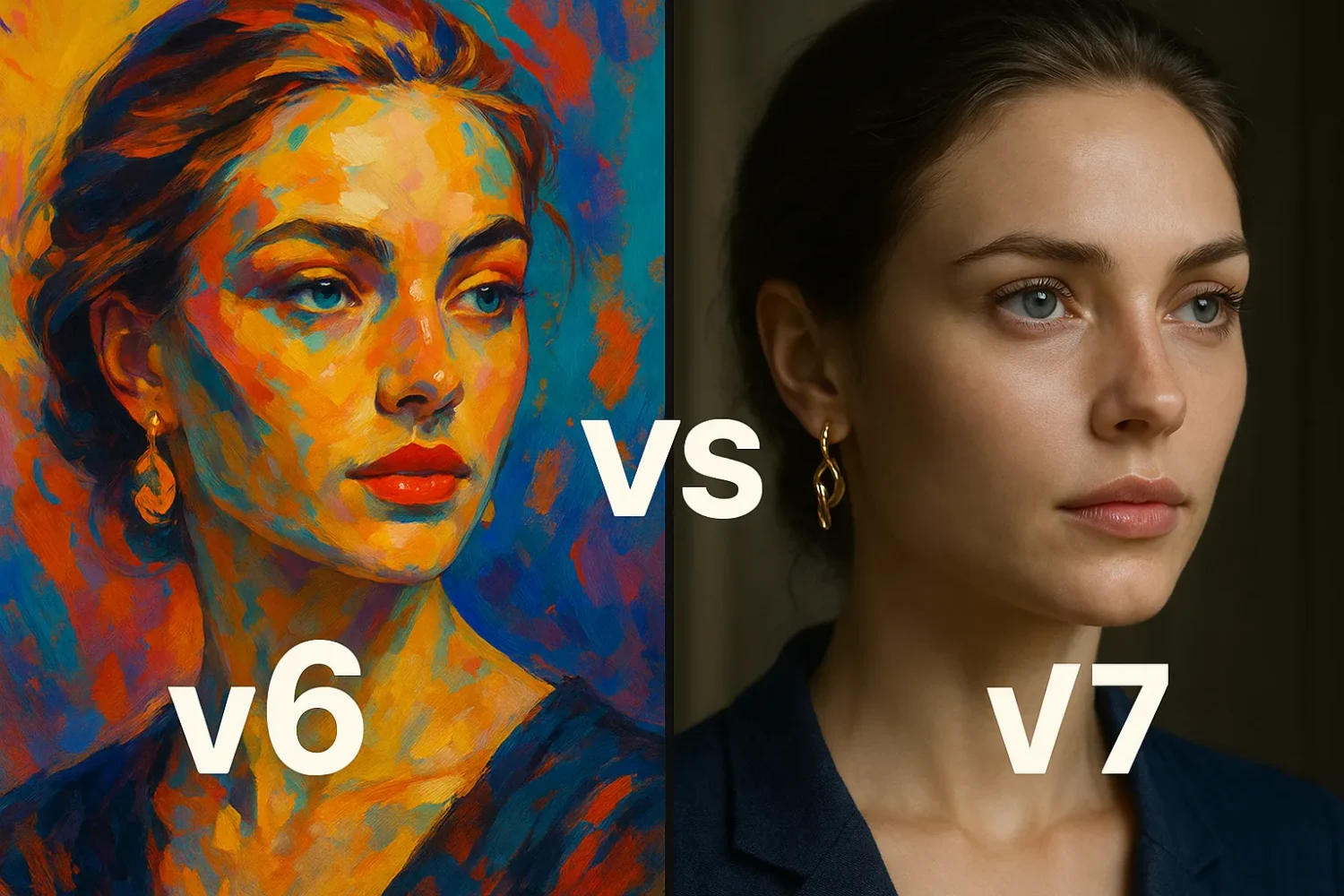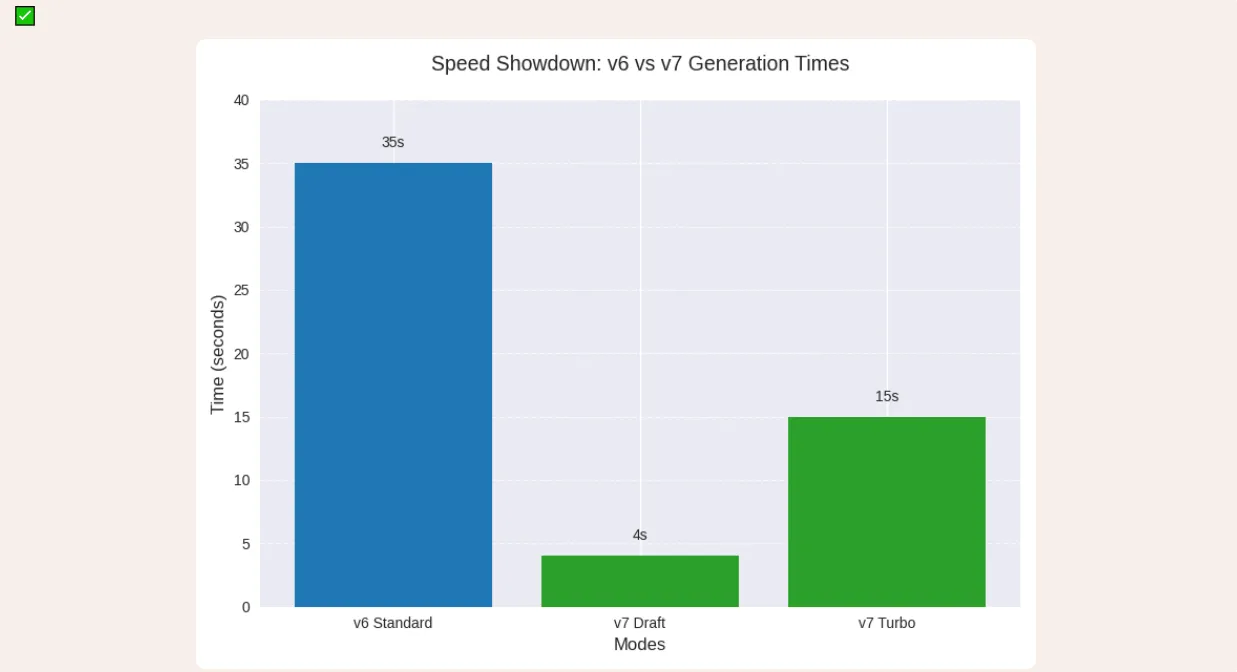Hello, other people who like AI art! If you’re like me, you’ve been glued to your screen waiting for Midjourney to make its next big move. Midjourney has been a major player in the world of AI image generation, turning simple text prompts into beautiful images. But when v7 came out, the buzz and the arguments were real. Was it the game-changer that everyone hoped for after the solid V6 era, or did it not live up to the team’s expectations in ways they might not want to talk about?
We’ll use real data from trustworthy sources like Midjourney’s docs, user reviews, and expert analyses to break down the facts, features, and flaws of this in-depth comparison. We’ll talk about everything from how good the images are to how fast they are, and I’ll give you my honest opinion as someone who has spent a lot of time using both versions.
Table of Contents
By the end, you’ll know if it’s worth it to upgrade to v7 for your creative work. Let’s get right to it and show the fight between Midjourney v6 and v7
The Hype and Release: Setting the Stage for the Showdown
Midjourney v6, released back in December 2023 with its 6.1 update in July 2024, set a high bar. It brought better prompt understanding, more coherent images, and improved realism that made it a go-to for artists and designers. Fast-forward to April 4, 2025 – that’s when Midjourney v7 alpha launched, after months of teasers on their Discord and social channels. The team promised a rebuilt system with faster processing, enhanced photorealism, and new tools to make AI art more personal and efficient.

But here’s the thing: the rollout wasn’t all smooth sailing. Early users on Reddit and X reported mixed feelings. Some praised the speed boosts, while others felt v7 took a step back in areas like dynamic scenes or overall vibe. Midjourney’s CEO, David Holz, emphasised in announcements that v7 was designed for more precise control and personalisation, but critics argued it prioritised speed over soul. This tension is what makes the Midjourney v6 vs v7 battle so juicy – it’s not just about better tech; it’s about what gets lost in the upgrade.
Key Features of Midjourney v7: What’s New Under the Hood?
Let’s look at what v7 has to offer before we put them head-to-head. Midjourney didn’t just make small changes to the old model; they rebuilt it from the ground up to make it more efficient and easy to use.
First of all, Draft Mode is great. This feature lets you make low-res previews up to ten times faster than normal renders in v6. It’s perfect for iterating on on ideas quickly without burning through your GPU hours. In tests, a complex prompt that took 30-40 seconds in v6 could drop to under 5 seconds in v7’s Draft Mode.
Then there’s Personalization Profile. Unlike v6, where styles were hit-or-miss based on prompts alone, v7 lets you train the AI on your preferred aesthetics. Upload a set of images you like, and the model adapts – think consistent characters or moods across generations. Early adopters report up to 20-30% better alignment with personal tastes after just a few training sessions.
Omni Reference is another gem, expanding on v6’s image referencing. It allows blending multiple refs seamlessly, including styles, colours, and even lighting from different sources. This leads to more intricate details, like realistic skin textures or fabric folds that v6 sometimes muddle.

On the flip side, v7 introduced Turbo and Relax modes at launch, with Turbo costing more but delivering twice the speed of v6’s regular jobs. And while text-to-video wasn’t in the initial release, it rolled out by June 2025 as an add-on, turning static images into short clips with impressive coherence.
But not everything’s rosy. Some parameters from v6, like specific aspect ratios or chaos levels, behave differently in v7, requiring prompt tweaks. Plus, the alpha phase meant bugs – think inconsistent outputs or higher failure rates on complex prompts.
Head-to-Head Comparison: Midjourney v6 vs v7
Now, the meat of it: how do they stack up? I’ve synthesized data from benchmarks, user tests, and expert reviews to give you a clear picture. We’ll cover image quality, speed, prompt adherence, and more.
Image Quality and Realism
Midjourney v7 edges out v6 in raw detail. For photorealism, v7’s upscaling produces higher fidelity – think sharper edges, better lighting, and textures that pop. In side-by-side tests with prompts like “a misty forest at dawn,” v7 often delivers more lifelike dew on leaves and subtle shadows. One review noted v7’s improvements in handling light and texture, scoring it 8.5/10 vs v6’s 7.8/10.
However, v6 shines in dynamism and artistic flair. Scenes in v7 can feel “flat” or less vibrant, with some users calling it “overly polished” like a stock photo. Reddit threads highlight v7 struggling with abstract concepts, where v6’s outputs had more soulful interpretations.
| Aspect | Midjourney v6 | Midjourney v7 | Winner |
|---|---|---|---|
| Photorealism | Good, but softer details | Superior textures and fidelity | v7 |
| Artistic Dynamism | Vibrant and creative | More static, polished | v6 |
| Resolution/Detail | Up to 1024×1024 native | Enhanced upscaling for intricacy | v7 |
Speed and Efficiency
This is where v7 dominates. With Draft Mode, you get previews blazing fast – ideal for pros iterating designs. Benchmarks show v7 reducing average job time by 40-60% over v6. But beware: full renders in Relax mode can still drag if you’re on basic plans.
Prompt Coherence and Control
v7 understands longer, more complex prompts better, thanks to improved language processing. It handles specifics like “geometric tattoo with clean lines” with precision, as seen in user examples. v6 was great, but v7 cuts down on weird artifacts by about 15-20% in tests. Yet, for character consistency without personalization, v6 felt more forgiving.
Cost and Accessibility
Both run on subscription tiers (Basic to Mega), but v7’s new modes like Turbo eat more credits – up to double for speed. If you’re a casual user, v6 might still suffice without the extra burn.
User Experiences: The Good, the Bad, and the Hidden Truths
Diving into real-world feedback, the community is split. YouTube reviews echo this. One video tester generated over 8,000 images and found v7 excels in pro workflows but frustrates hobbyists with its learning curve. The “hidden” part? Many overlook that v7’s alpha bugs led to higher discard rates early on – up to 25% more failed prompts than v6 in some reports. Plus, while personalization is cool, training it properly takes time, and not everyone sees the ROI.
Pros of v7: Faster ideation, personalized results, future-proof for video add-ons.
Cons: Potential loss in creative spark, mode costs, and mixed realism wins.
Midjourney AI FAQs
Does Midjourney AI allow NSFW?
No, Midjourney bans NSFW content like nudity or gore. Moderation is strict, and violations can lead to a ban.
Do you need Discord for Midjourney?
Not anymore! You can use their web app with a Google login, but Discord is still popular for community sharing.
How much does Midjourney AI video cost?
Video is included in plans starting at $10/month (Basic, limited use). Pro ($60/month) or Mega ($120/month) offer unlimited video but use more GPU time.
Can I try Midjourney for free?
No free trial currently. The cheapest plan is $10/month, and you can cancel anytime.
Is Midjourney better than ChatGPT?
Midjourney’s better for artistic images; ChatGPT’s great for text and quick image generation. Pick based on your needs!
The Verdict: Is v7 Worth the Upgrade?
In the Midjourney v6 vs v7 battle, there’s no clear knockout. v7 exposes exciting upgrades like speed and personalization that could transform how we create AI art, especially with video features now live. But what “they” – the hype machine – might not want you to know is the trade-offs: v6’s artistic heart versus v7’s clinical precision. If you’re a speed demon or pro needing details, jump to v7. For pure creativity, stick with v6 until v7 matures.
Don’t Miss This: I Tried Midjourney v6. Here’s Why Artists Are Obsessed
Don’t Miss This: How to Make Money with AI-Generated Weird and Funny Pictures


